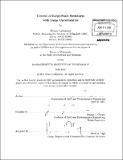Control of large-scale structures with large uncertainties
Author(s)
Laflamme, Simon, Ph. D. Massachusetts Institute of Technology
DownloadFull printable version (42.16Mb)
Other Contributors
Massachusetts Institute of Technology. Dept. of Civil and Environmental Engineering.
Advisor
Jerome J. Connor.
Terms of use
Metadata
Show full item recordAbstract
Performance-based design is a design approach that satisfies motion constraints as its primary goal, and then verifies for strength. The approach is traditionally executed by appropriately sizing stiffnesses, but recently, passive energy dissipation systems have gained popularity. Semi-active and active energy dissipation systems have been shown to outperform purely passive systems, but they are not yet widely accepted in the construction and structural engineering fields. Several factors are impeding the application of semi-active and active damping systems, such as large modeling uncertainties that are inherent to large-scale structures, limited state measurements, lack of mechanically reliable control devices, large power requirements, and the need for robust controllers. In order to enhance acceptability of feedback control systems to civil structures, an integrated control strategy designed for large-scale structures with large parametric uncertainties is proposed. The control strategy comprises a novel controller, as well as a new semi-active mechanical damping device. Specifically, the controller is an adaptive black-box representation that creates and optimizes control laws sequentially during an excitation, with no prior training. The novel feature is its online organization of the input space. The representation only requires limited observations for constructing an efficient representation, which allows control of unknown systems with limited state measurements. The semi-active mechanical device consists of a friction device inspired by a vehicle drum brakes, with a viscous and a stiffness element installed in parallel. Its unique characteristic is its theoretical damping force reaching the order of 100 kN, using a friction mechanism powered with a single 12-volts battery. It is conceived using mechanically reliable technologies, which is a solution to large power requirement and mechanical robustness. The integrated control system is simulated on an existing structure located in Boston, MA, as a replacement to the existing viscous damping system. Simulation results show that the integrated control system can mitigate wind vibrations as well as the current damping strategy, utilizing only one third of devices. In addition, the system created effective control rules for several types of earthquake excitations with no prior training, performing similarly to an optimal controller using full parametric and state knowledge.
Description
Thesis (Ph. D.)--Massachusetts Institute of Technology, Dept. of Civil and Environmental Engineering, 2011. Cataloged from PDF version of thesis. Includes bibliographical references (p. 279-300).
Date issued
2011Department
Massachusetts Institute of Technology. Department of Civil and Environmental EngineeringPublisher
Massachusetts Institute of Technology
Keywords
Civil and Environmental Engineering.